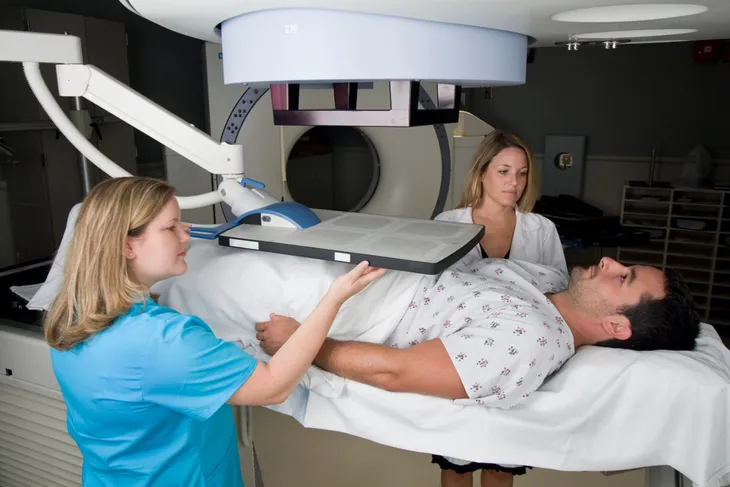Prostate cancer is a form of cancer only found in men. As such, it is the second most deadly form of cancer for men in the United States. The overall risk of developing prostate cancer is roughly one in nine. This means that approximately 191,000 new cases of prostate cancer will be diagnosed this year alone.
Some prostate cancers are slow-growing, limited to the prostate, and do not require immediate treatment. However, rarer cancers are more aggressive. As with all forms of cancer, the key to successfully managing and treating prostate cancer is to catch the disease as early as possible.
What Is Prostate Cancer?
All forms of cancer behave similarly when they first develop, irrespective of where in the body cancerous tissue arises. Cancer occurs when cells in organs or tissues become damaged and start to reproduce at an unhealthy rate. This will eventually lead to the formation of tumors, which could spread to other areas of the body.
Prostate cancer begins in a small gland situated between the bladder and rectum that is primarily responsible for producing seminal fluid. Prostate cancer is categorized according to which cells in the prostate are affected, how advanced the cancer is, and whether it had spread to other organs and tissues. Fortunately, 90 percent of prostate cancer cases are diagnosed before they have spread beyond the prostate.
Types of Prostate Cancer
There are several types of prostate cancer, though some are far more common than others. The vast majority of prostate cancers are adenocarcinomas, with other forms of cancer accounting for less than one percent of all new cases. This common type of cancer is very treatable, especially when picked up before tumors have spread elsewhere in the body.
Less common types of prostate cancer include:
- Small cell carcinomas
- Neuroendocrine carcinomas
- Transitional cell carcinomas
The following two terms may also be used in reference to certain prostate cancers:
- Recurrent Prostate Cancer: When malignant cancerous cells recur in the prostate, despite being previously eliminated.
- Metastatic Prostate Cancer: When cancerous cells have spread from the prostate to other organs or tissues. Let’s explore this type in more detail next.
Metastatic Prostate Cancer
If your doctor tells you that your cancer is metastatic or has metastasized, that means your prostate cancer has spread to other parts of your body, says WebMD.
Prostate cancer typically spreads to the bones, lymph nodes, liver, or lungs. The source notes, “It’s rarer for it to move to other organs, such as the brain.”
Metastatic Prostate Cancer Treatment
Metastatic prostate cancer is an advanced form of cancer and unfortunately, there is currently no cure. That said, you will work with your doctor and health team to treat it and control it.
The ultimate goals of treatment are to slow the rate of growth, shrink the tumor, and manage your symptoms.
 novak.elcic / Shutterstock
novak.elcic / ShutterstockWhat Is Prostate-Specific Antigen?
Prostate-specific antigen (PSA) is a protein produced in the prostate gland. PSA testing can be a useful tool in the diagnosis, staging, and ongoing treatment of prostate cancer, as problems with the prostate can increase the amount of PSA in the bloodstream. Though, there are several other conditions of the prostate which can alter PSA levels.
What Is the Connection Between Prostate Cancer and PSA?
Healthy men without prostate cancer usually have trace amounts of PSA in their bloodstream. Certain conditions – including prostate cancer – can cause the prostate to over-produce PSA, leading to unusually high levels in the blood. Other conditions that can lead to increased PSA are enlarged prostate and prostatitis. Doctors often use PSA testing as a diagnostic tool to determine whether a patient has prostate cancer and for early screening in older men.
PSA testing requires a small sample of blood to be taken from the patient. Antigen levels are then measured and expressed in nanograms per milliliter of blood (ng/ml). If you undergo a PSA test, keep in mind that high PSA levels alone do not indicate that cancer is present.
What Are Normal PSA Levels?
What counts as a “normal” PSA level is different for every man and is affected by age. In general, older men tend to have higher PSA levels than younger men. The following is for guidance only:
- 0 to 2.5ng/mL – Safe
- 2.6 to 4ng/mL – Safe in most cases
- 4 to 10ng/mL – Cause for concern
- 10ng/mL or higher – Dangerous
PSA and Prostate Cancer Staging
Prostate cancer stages run from 1 to 4, with 4 being the most advanced stage and 1 being the least advanced stage. PSA levels can help doctors to determine the stage of prostate cancer, as follows:
- Stage 1: The cancer is limited to one half of the prostate and has not spread to other tissues. PSA levels are below 10.
- Stage 2A: The cancer is limited to one half of the prostate and has not spread. PSA levels are between 10 and 20.
- Stage 2B: The cancer has affected both sides of the prostate, PSA levels are greater than 20, or both.
- Stages 3 and 4: The cancer has spread to other tissues. The extent to which this has occurred determines the stage. PSA levels are no longer considered.
What Are the Early Symptoms of Prostate Cancer?
The early symptoms of prostate cancer often include:
- Bloody urine
- Frequent urination
- Erectile dysfunction
- Discomfort while sitting down
- Difficulty urinating
Advanced Prostate Cancer Signs
When prostate cancer spreads to other tissues beyond the prostate a variety of other symptoms can develop. One sign of advanced prostate cancer is bladder and urinary troubles such as urinating more frequently, the feeling of having to urinate often but not actually passing anything, incontinence, and blood in the urine.
Unexplained weight loss, fatigue, and pain in the back, thighs, or hips are also common. Individuals with advanced prostate cancer may also experience unusual bowel habits such as constipation or blood in the stool. If you develop any of these symptoms make sure you see your doctor right away.
Prostate Cancer Treatment Options
The prostate cancer treatment a doctor recommends will depend on the stage of the cancer and whether it has spread. Overall health, age, and the personal preferences of the patient are also factors in determining treatment.
Stage 1
Active surveillance is often recommended for younger men. If the patient is older or wishes to start treatment, doctors may advise radiation therapy or radical prostatectomy.
Stage 2
Depending on the size of the cancer, active surveillance may still be an option. Doctors may also recommend radiation therapy, brachytherapy, hormone therapy, or a combination of these treatments.
Stage 3
Treatment options for cancers that have spread locally may include radiation therapy plus hormone therapy, radical prostatectomy, and removal of pelvic lymph nodes.
Stage 4
Advanced prostate cancer may warrant chemotherapy. Complimentary treatment options are radiation therapy, hormone therapy, and surgery to alleviate symptoms such as urinary obstruction.
Talk to Your Doctor
Make an appointment with your doctor if you are concerned about prostate cancer or are experiencing any of the symptoms discussed in this article. Men over the age of 45 may wish to arrange prostate cancer screening; your doctor will help you to decide whether this is appropriate.














